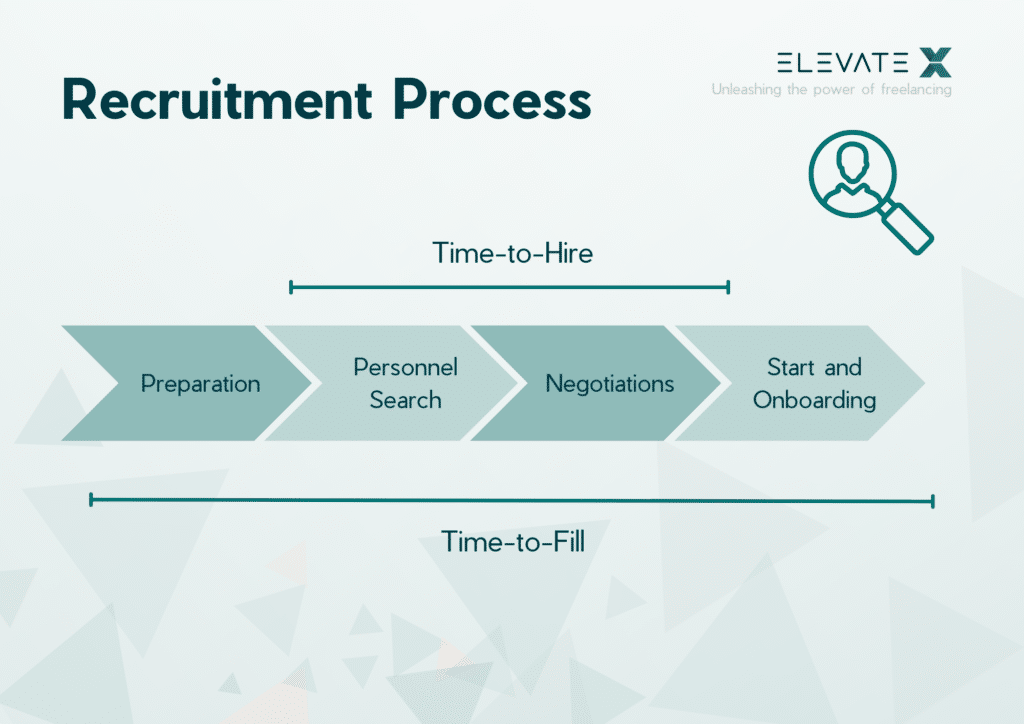Time-to–hire is one of the most important metrics in HR or personnel departments – and not without reason. An efficient time-to–hire can set a company on the path to success, while a significantly improvable timeframe can hinder the company in its development and even in everyday tasks. In this context, freelancers play a key role.
Time-to-Hire: What Is It?
Initially, it is necessary to differentiate it from “Time-To-Fill.” Especially the term “vacancy time,” a common translation into German, is sometimes not used specifically enough. “Time-To-Fill” encompasses the period that begins with the search for a workforce and ends on the day this workforce starts their first day of work.
In contrast, “Time-to-hire” is more narrowly defined and automatically a part of the “Time-To-Fill” period. The time-to-hire metric describes a period that begins with the actual recruiting process and ends with the filling of the position – typically the signing of the employment contract. From the perspective of HR professionals, a distinction between the two terms is urgently necessary, as otherwise the respective metrics would lose some of their informative value and only present a distorted picture.
Illustrated on a timeline, the difference becomes clearer:
- Identification of staffing needs.
- Application process, interviews, etc. (part of time-to-hire).
- Offer, contract signing, and hiring (also time-to-hire).
- Onboarding and the first workday of the original applicant
Both the first and the last point are no longer part of the time-to-hire, but rather the Time-To-Fill. Especially digitalization can help HR professionals to sustainably optimize both metrics, but this requires prior sequencing and analysis of potential weak points in the recruiting process.

KEY POINTS
- Time-to-hire indicates how long it takes to fill a position within the recruiting process.
- Time-to-hire is part of the Time-To-Fill/vacancy period and is therefore always shorter than it.
- Particularly in the face of skilled labor shortages, this metric plays a key role. To aim for a reduction, the recruiting process should be analyzed and individual sequences optimized.
How to Calculate Time-to-Hire?
The actual calculation formula for time-to-hire is quite straightforward:
Time-to-hire = Day of offer acceptance – Day of application submission
(or alternatively chosen start and end points)
In this regard, individual key points need to be defined, which are later inserted into the formula. Specifically, HR professionals and companies are responsible for defining the correct start and a clear end of the recruiting process. The points mentioned above should be considered to differentiate from Time-To-Fill.
Examples of the start of recruitment could be:
- Approval of the position to be filled by the works council.
- Public dissemination of the job advertisement, for example, by uploading the advertisement on suitable portals.
- Instruction from the department to prepare the recruiting process for position xy.
Examples of the end of the recruiting process might include:
- Job advertisement is removed from the respective career portal.
- The department agrees with and on a candidate.
- The employment contract is signed.
It is important that the beginning and end are not changed between calculations, as this would lead to a significant distortion of the results.
Example of a Correct Calculation
Initial Situation: A company advertises a job position and receives applications. After conducting the application process, the company selects a suitable candidate.
Calculation Example:
- Date of Application Submission: The selected candidate submitted their application on March 10th.
- Date of Offer Acceptance: After interviews and evaluations, the candidate accepts the job offer on March 25th.
- First Day of Work: April 1st.
Calculation of Time-to-Hire:
Time-to-Hire = Date of Offer Acceptance – Date of Application Submission = March 25th – March 10th = 15 days
In this example, the Time-to-Hire is 15 days. This is the time that has elapsed from the start of the recruiting process (application submission) to the candidate’s acceptance of the job offer. The additional approximately 6 days until the first day of work belong to the Time-to-Fill.
This formula, each with a start and end date, can be used for each individual filled position. HR professionals could then form the average by adding up the respective days per hired applicant and then dividing them by the number of filled positions.
Benchmark: Average Time-to-Hire in Germany
In practice, such a short period as in the example above is not necessarily to be expected. According to Workwise, the average time-to-hire in Germany is 78 days – although this is, of course, highly dependent on the position to be filled and the start and end points chosen by the companies. Therefore, this benchmark should only serve as a rough orientation.
Generally, in highly sought-after industries and professions, a higher time-to-hire is to be expected than in other professions. In a hair salon, a vacancy can generally be filled faster than in highly specialized IT – simply because there are more applicants, and the applicants usually cannot choose between several offers due to the limited demand.
Examples of highly sought-after professionals in rapidly growing industries include:
- Data Analyst
- AI Developer
- Scrum Master
- UX Designer
- App Developer
Therefore, both in Germany and in other parts of the world, the more specialised the profession and the smaller the field of applicants, the longer the expected time until the position can actually be filled.
For this reason, it is not very helpful for companies to orient themselves on cross-industry benchmarks. It is absolutely conceivable that the time-to-hire in one profession and industry lasts several months or even a year, while in other industries and professions, it is only two weeks. This is also shown by benchmarks from the USA, where time-to-hire varies depending on the profession from about 6 days to over a year, averaging about 44 days.
What Are the Costs of a Long Time-to-Hire?
Many companies quite literally cannot afford to have an above-average time-to-hire. It is not without reason that the economy repeatedly complains about the shortage of skilled labour, which by no means only affects the well-paid skilled labour sector – Germany also regularly lacks candidates in the low-wage sector.
From a company’s perspective, it is advisable to shorten the time-to-hire as much as realistically possible. A high time-to-hire incurs both direct and indirect costs. These are not always immediately apparent, especially the indirect costs. Nevertheless, entrepreneurs know that vacant positions remaining open longer than intended are not conducive to company success and internal business processes.
Direct Costs
- Personnel costs: The time HR staff spend on the complete selection and application process.
- Advertising expenses: Costs incurred due to the (longer) use of job portals.
- Applicant expenses: For example, reimbursing applicants for expenses and travel costs for interviews.
For obvious reasons, many applicants and a long time-to-hire lead to additional costs. Further delays are conceivable, for example, due to absences or in the context of the widely discussed four-day workweek.
Indirect Costs
- Productivity losses: Due to missing skilled workers, individual or multiple processes in the company run less efficiently, thereby reducing productivity.
- Opportunity costs: Because of the lack of specific expertise, processes or projects may not be implemented, causing the company to miss out on profits.
- Costs due to competitive losses: As specialized knowledge is not filled by suitable candidates, competitors can gain market shares, leading to long-term market share losses for the organization.
Such indirect costs, known as opportunity costs, are often much higher than the direct costs. In the worst case, the company may partially or fully lose its competitiveness or have to permanently shut down entire processes.
Time-to-Hire and Cost of Vacancy
Time-to-Hire is closely linked to the vacancy costs incurred by a company. Vacancy cost, or Cost of Vacancy, is a classic metric in a company’s recruiting and is often used to plan the recruiting budget. It describes the costs caused by an unfilled position within a company.
The longer the duration of the Time-to-Hire, the higher the vacancy costs for a company.
To better understand and quantify the impact of a vacant position on your company, we at ElevateX offer a special cost of vacancy calculator. This tool enables precise calculation of the costs of an open position. It provides valuable insights and can contribute to taking targeted measures to optimize your recruiting processes, thereby minimizing the financial burden of unfilled positions.
Reduce Your Time-To-Hire Now by Finding the Right Freelancers
How Can Time-to-Hire Be Reduced?
Freelancer
Freelancers from ElevateX are a proven means to reduce vacancy periods. Freelancers are available at short notice, and the bureaucratic processes are far less extensive than with permanently employed staff. Furthermore, companies have the advantage of remaining flexible with freelancers, which also increases the organization’s agility.
Optimizing the Recruitment Process
- Branding: Strong and positively perceived brands and employers attract more skilled workers.
- Analyzing sequencing in the recruiting process: Identify where weaknesses exist in the entire recruiting process, where time delays occur, or where applicants drop out.
- Target group approach: Specifically address the respective needs and desires of the skilled workers.
- Streamlining decision-making processes: Clearly define tasks and decision-making powers in advance to avoid delays due to coordination between numerous employees.
In general, two approaches can be taken: hiring freelancers to cover the vacancy and/or alternatively revising the application process in its entirety. A strong company branding that attracts applicants and helps them identify with the company is additionally helpful in both aspects.
Conclusion
Not being able to fill positions or requiring a lot of time to do so costs HR personnel not only nerves and time but also potentially a lot of money for companies and organizations and, in the long term, their competitiveness. Therefore, it is worthwhile to approach the process holistically while also considering the market of freelancers as flexibly and agilely available labor and skilled workers
Time-to-hire is the measured time from the beginning of the recruiting process to the signing of the employment contract. This metric is automatically a part of the Time-To-Fill, which describes the entire process from identifying a staffing shortage to onboarding the new employee.
The longer it takes to find a candidate, the higher the vacancy costs. These are direct costs, such as the time spent by HR staff, as well as indirect costs – when a company can no longer operate as efficiently as a result of the vacancy, or business processes come to a halt due to a lack of capacity and missing expertise.
Freelancers can significantly contribute to filling a vacancy, as they are available more quickly and flexibly than permanent staff. It is also worthwhile to analyze the recruiting process, for example, to identify where applicants drop out or which parts of it take up too much time.








